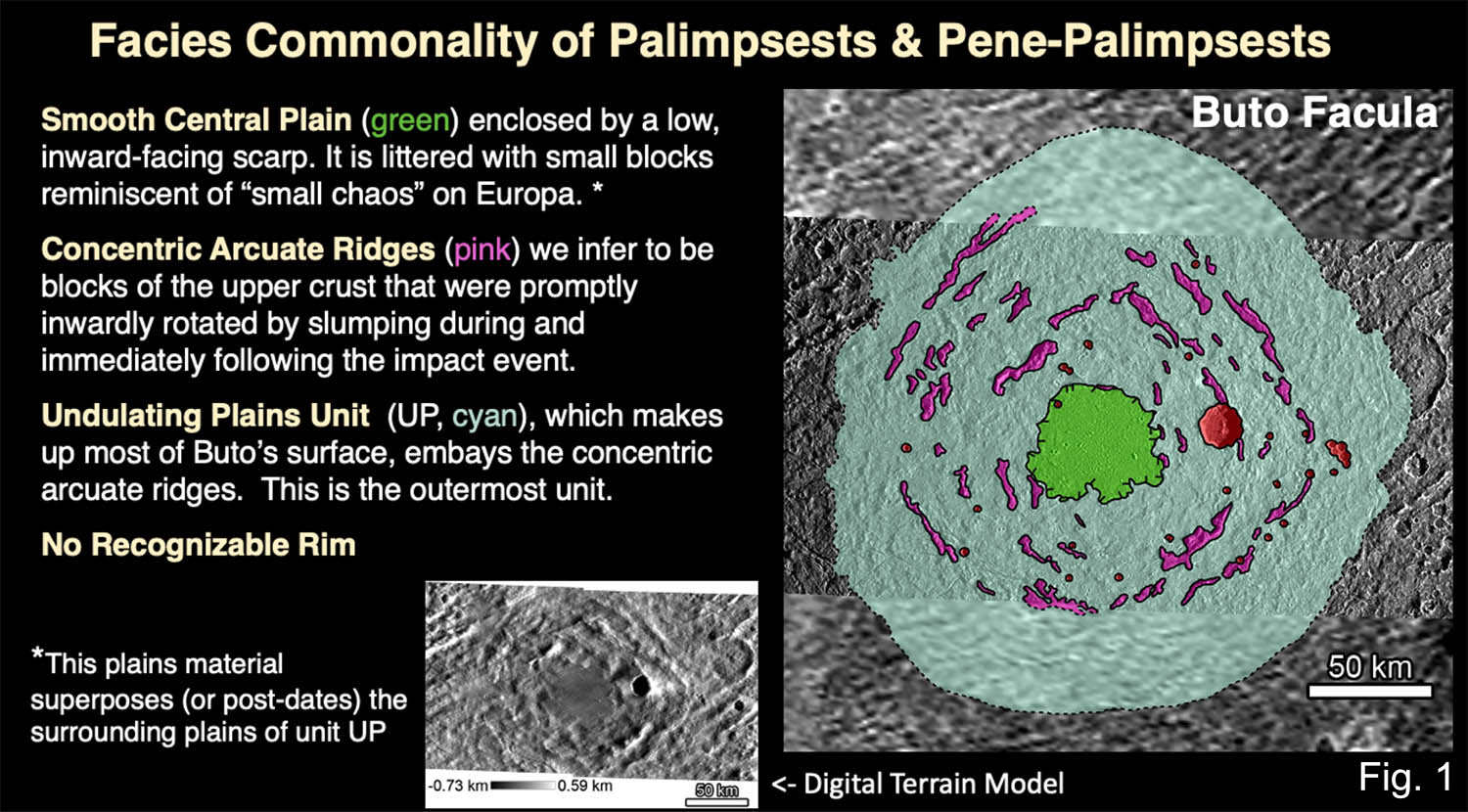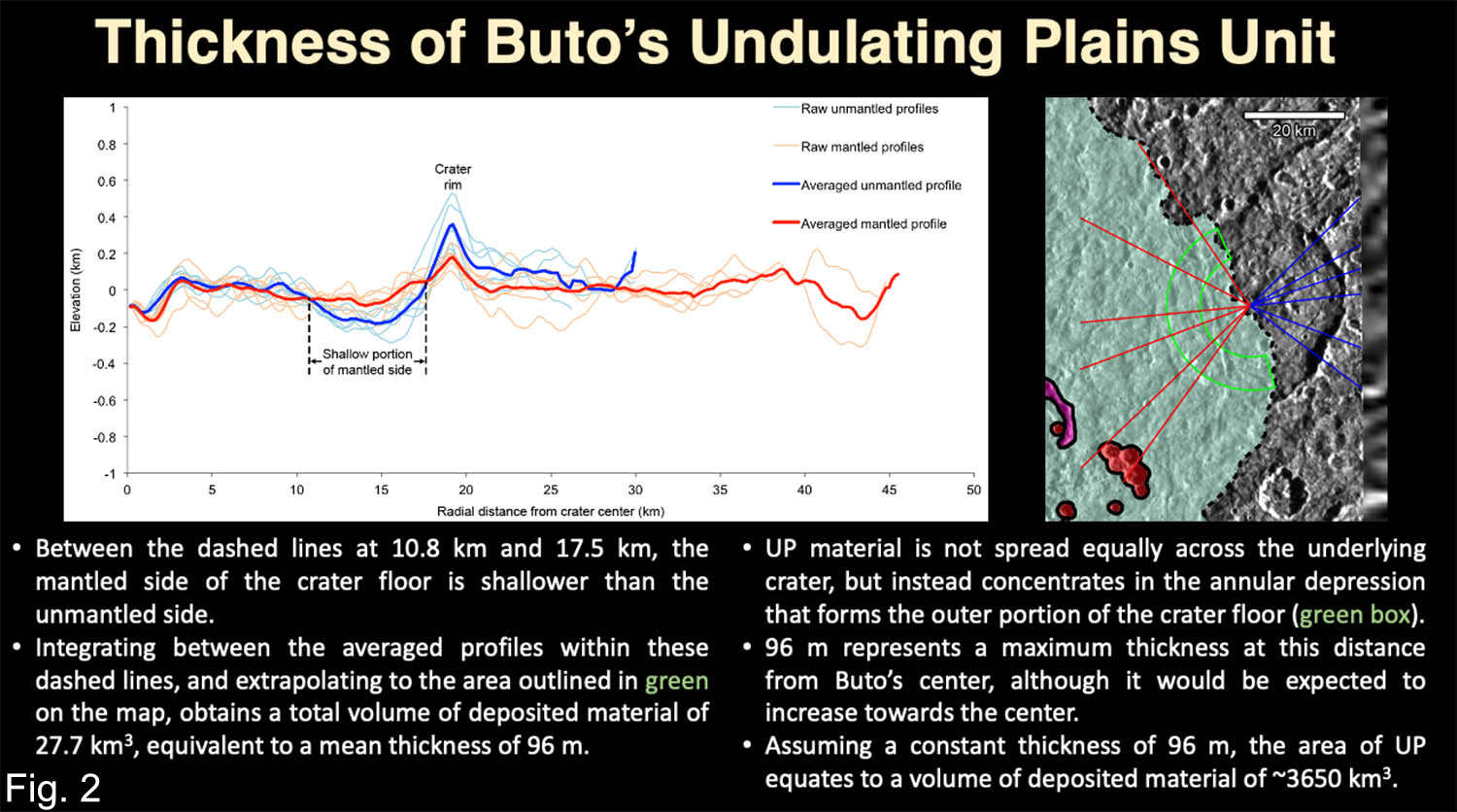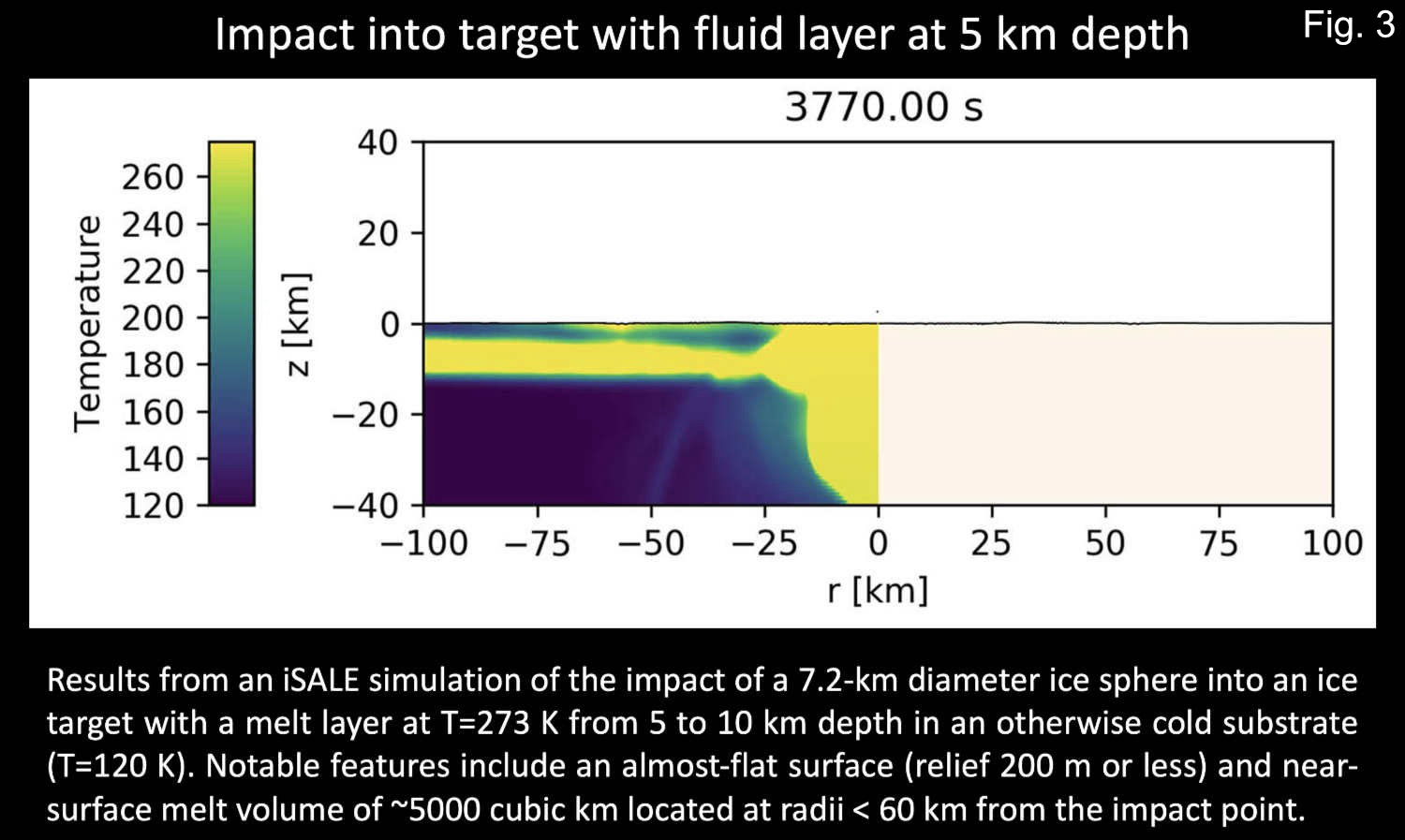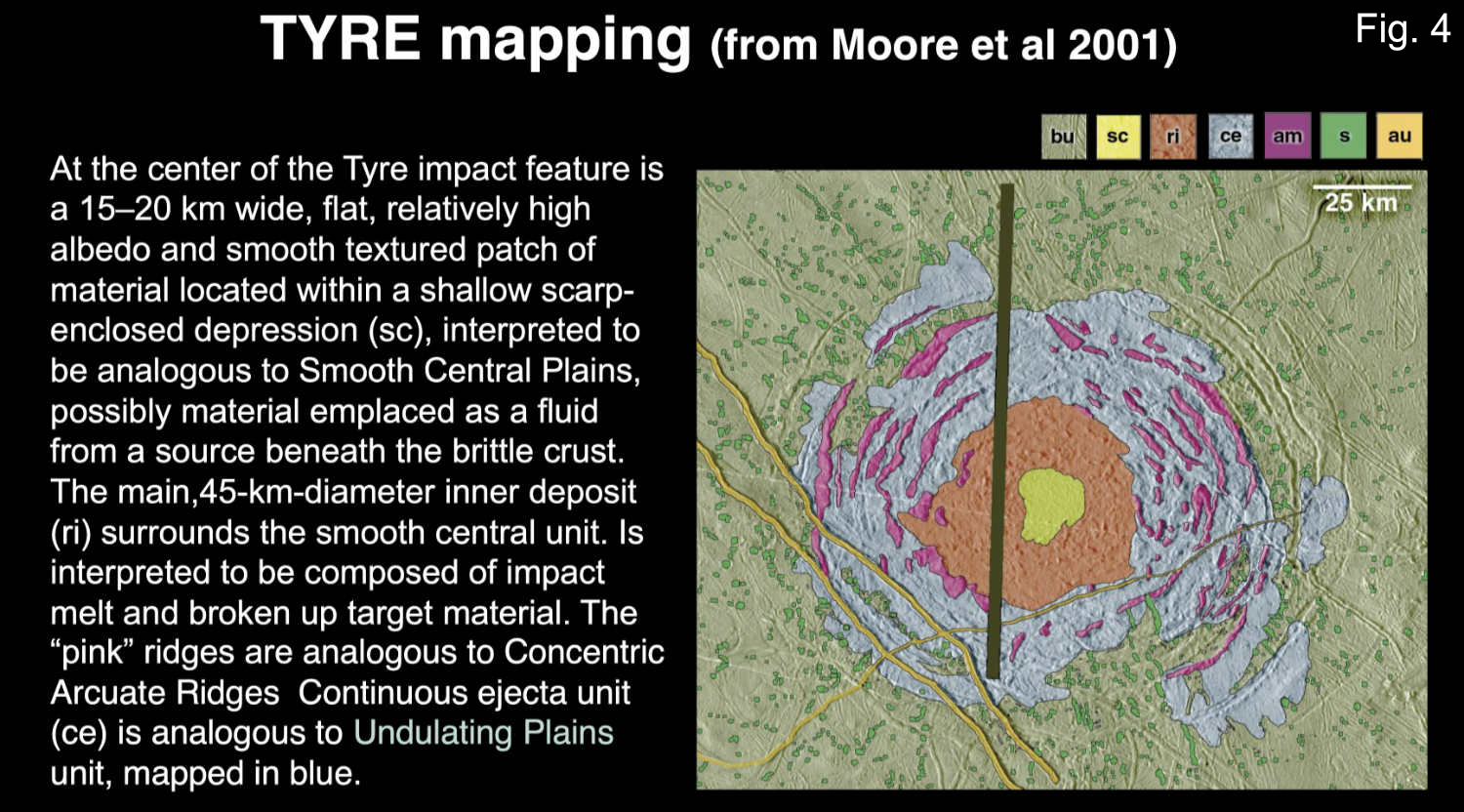- 1NASA Ames Research Center, Moffett Field, United States of America (jeff.moore@nasa.gov)
- 2UCSC Santa Cruz, CA USA
- 3Washington University, St. Louis, MO USA
- 4SETI Institute, Mountain View, CA USA
- 5LPI, Houston, TX USA
- 6University of IL., Chicago, IL USA,
Nowhere in the solar system are impact morphologies observed in greater variety than on the icy Galilean satellites. This is very likely a consequence of the structural and thermal state of the crust at the time of impact, and perhaps impact velocity. We have conducted a multi-disciplinary investigation to study how these features formed. The particular combination of geophysical factors and impactor characteristics that is shared by these satellites is likely responsible for these features. We have derived Digital Terrain Models for a number of these features, which have been used as a tool for producing facies maps.

Impact features on Ganymede and Callisto are relatable to impact features on Europa, with implications for its ice shell history. We have identified two broad classes of these impact features: (a) Crater forms, which variously include pits, central domes, and crater rims; and (b) Palimpsests (including pene-palimpsests), which all have smooth enclosed central plains, an extensive outer undulating plains unit, concentric arcuate ridges (in the case of pene-palimpsests), and no recognizable rim as in the example of Buto (Fig. 1). The measured volume of Buto’s Undulating Plains unit (Fig. 2) is a factor of two smaller than that of ejecta from an impact into a cold (T=120 K) target, as found from hydrocode modeling using the iSALE code, or ejecta scaling relations (Housen and Holsapple 2011).

We hypothesize that the undulating plains material may have been derived from a fluid or “slushy” layer (if present) in the near-surface target at the time of impact. In the next section of this abstract we report the latest modelling of this possibility The recognition of undulating plains as the dominant unit in Memphis and Nidaba, two other palimpsests on Ganymede that we have mapped (which display highly variable crater counts, with Buto being the least cratered), leads us to a working hypothesis that these plains only form where and when the target has substantial near surface fluid or “slush.” By extension, all other impact features on Ganymede and Callisto, such as those with central pits and central domes, formed in targets with no pre-existing, or at most inconsequential, amounts of fluid or “slush.” Supporting this conclusion, modeling by members of our group indicates that the present topography of impact features with central pits and domes can be largely explained by the behavior of ice alone, with no or little contribution from fluids (Caussi et al., 2024). Our study supports explanations for the formation and final appearance of palimpsests (and pene-palimpsests) that are entirely applicable to this feature class, and sharply distinct from explanations for other impact features (crater forms) on Ganymede and Callisto.
Modelling of fluid ejecta emplacement
Recently performed Impact simulations incorporating a subsurface fluid layer (or low strength layer) at shallow depth 5-10 km produce a nearly flat surface profile with excavated material that may match the observed layer (Fig. 3).

Two sample iSALE simulations produced near-surface melt volumes of 3600 and 5000 cubic km within radii of 60 km from the impact point, amounts very close to the inferred volume of the UP layer. Bear in mind that using formulation from Kraus et al. (2011) that impact events of the scale of Buto may produce at least 10% melt in the ejecta as well. The role of the pre-existing 5-10 fluid layer in our iSALE models most profoundly affects the final profile of the impact feature. In contrast, no fluid layer, and fluid layers >40 km deep, result in ”final” impact feature profiles with resemble classic craters.
Implications for Europa
Tyre (fig. 4) and Callanish, if analogues to pene-palimpsests, are much smaller than the Ganymede and Callisto features. The pene-palimpsests of Ganymede and Callisto formed within their ice crusts (and upper mantles) in the first ~15% (?) of Solar System history, whereas Europa’s features and crust represent events of the last ~1% of Solar System history. Is Europa’s Tegid really analogous to dome craters on Ganymede and Callisto? Central domes are brighter and inferred to represent frozen impact-melt beneath the center of the craters. Can we see and map the extent of frozen sub crater impact-melt pools with GPR? Callisto and Ganymede’s upper non-ice crust composition and thicknesses may be different: we need more lab work with respect to fundamental radar properties. REASON “non-targeted” observations of pene-palimpsests and dome craters on Ganymede and Calllisto combined with RIME profiles of these features may be useful in determining how analogous Tyre, Callanish, and Tegid really are to the Ganymede and Calllisto features.

References
Caussi, M.L. et al. (2024) Dome craters on Ganymede and Callisto may form by topographic relaxation of pit craters aided by remnant impact heat. J. Geophys. Res., in press.
Housen, K. R. and Holsapple, K. A. (2011) Ejecta from impact craters. Icarus 211, 856-875.
Kraus , R. G., Senft, L. E., Stewart, S. T. (2011) Impacts onto H2O ice: Scaling laws for melting, vaporization, excavation, and final crater size. Icarus 214, 724-738.
Moore, J. M. et al. (2001) Impact Features on Europa: Results of the Galileo Europa Mission (GEM). Icarus, 151, 93–111.
References for iSALE
Amsden, A., Rupple, H., and Hirt, C. (1980) SALE: A simplified ALE computer program for fluid flow at all speeds. Los Alamos Nat. Lab. Rept. LA-8095.
Collins, G. S., Melosh, H. J., and Ivanov, B. A. (2004) Modeling damage and deformation in impact simulations. Met. Plan. Sci. vol 39, 217-231.
Wünnemann, K., Collins, G., and Melosh, H. (2006) A strain-based porosity model for use in hydrocode simulations of impact and implications for transient crater growth in porous targets. Icarus vol 180, 514-527.
How to cite: Moore, J., Korycansky, D., McKinnon, W., White, O., Schenk, P., Caussi, M., and Dombard, A.: Large Impact Features on Icy Galilean Satellites: New Modelling of fluid ejecta emplacement, Europlanet Science Congress 2024, Berlin, Germany, 8–13 Sep 2024, EPSC2024-103, https://doi.org/10.5194/epsc2024-103, 2024.